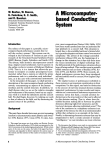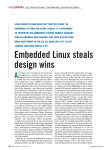Download designfeature Advanced VHDL constructs
Transcript
designfeature By Subbu Meiyappan and James Steele, VLSI Technology THE USE OF ADVANCED VHDL CONSTRUCTS CAN GREATLY ENHANCE MODELING EFFICIENCY. LEARN HOW TO EFFECTIVELY USE VHDL FOR DYNAMIC-MEMORY ALLOCATION, HIERARCHICAL TESTBENCHES, AND CREATING FOREIGNLANGUAGE INTERFACES FOR BEHAVIORAL MODELING. VHDL constructs and methodologies for advanceddesign verification he need to model memory is common in any LISTING 1—SIMPLE MEMORY MODEL USING STATIC ALLOCATION verification environment. The simplest way to model memory is to employ static allocation techniques using array data types. For example, to model a width-times-depth-sized memory, you use a construct similar to the one shown in Listing 1. For small memories, static-allocation techniques are the simplest to read, understand, and implement. The static-allocation method allocates the required Gbytes of memory. Even if you allocate all 4 Gbytes, memory before the program accesses memory—in each simulation run typically hits 10% or less of the other words, when the simulator starts up (at zero memory space, although these accesses can be ransimulation time). This method has some inherent dom. In other words, it is typical for a simulation to drawbacks: Every bit of allocated memory corre- toggle all the address bits but not access every byte sponds to several bits of physical memory; thus, sim- of memory. Because static-allocation techniques for ulator performance is limited for large memories. such deep memories greatly limit simulation perConsider a processor with a 32-bit-wide address formance, you should use methods to model membus. Theoretically, the processor can access 4 Gbytes ory efficiently such that the program allocates it in of memory. If you assume, while simulating the an “on-demand” basis using dynamic-allocation model of this processor, that every bit of allocated techniques. With dynamic allocation, the program memory corresponds to 1 bit of physical memory, allocates physical memory on demand on the host then a static-allocation scheme that allocates all of machine as the model simulates new transactions. this memory requires about 4 Gbytes of RAM (In a The approach described in this article is one of the real case, every bit of allocated memory corresponds classic methods that developers have used for comto several times that putational problems that use amount.) If the required data structures with staticalADDRESS ADDRESS ADDRESS RAM is unavailable, the proly nondeterministic depths. DATA DATA DATA gram translates the memory You usually solve such probaccesses into disk accesses, selems by implementing linked Nxt_Ptr Nxt_Ptr NULL verely slowing a simulation lists that a program creates run. On a statistical and builds dynamically on Figure 1 This flow chart demonstrates a note, no single typical demand. On-demand cresimulation run requires all 4 linked-list organization for a memory model. ation of a linked list of data T www.ednmag.com November 2 4, 1999 | edn 65 designfeature Advanced VHDL constructs structures and allocation of new memo- dress. If it finds an adLISTING 2—VHDL PACKAGE CONTAINING ry locations relies heavily on dynamic- dress match, the proMEMORY PROTOTYPES AND PRIMITIVES memory allocation and pointer-manip- gram returns the data ulation techniques. VHDL, using access in the node correspondata types, provides a mechanism to al- ding to that address. locate new memory locations on demand The program stores along with pointer arithmetic to manip- each node as a record ulate the pointers. References 1 and 2 de- data type that it creates tail dynamic-memory allocation using dynamically on deaccess data types and linked lists. De- mand. The Nxt_Ptr signers use an application of access data must be of an access types to dynamically create linked lists type the program uses for efficient memory modeling. Note that to point to the next the access data types are nonsynthesiz- node. A first attempt to able VHDL constructs, so you can use write the type declarathem only for simulations. tions for this structure Listings 2 and 3 illustrate the imple- might look like the mentation of a complete VHDL package code in Listing 4. for sparsely allocatListing 4 shows ed memories. This that the definition of Addr0 Data0 Addr1 Data1 method of modelmem_entry uses the Addr2 Data2 ing memory is type entry_ptr as the . . efficient in randomdata type of one of its . . . . simulation environelements but does not AddrN DataN ments in which the declare entry_ptr unprogram randomly til after the definition From a accesses of mem_entry. To Figure 2 user’s permemory. solve this “chicken-orListing 2 is the spective, the flow the-egg” problem, VHDL description chart in Figure 1 Listing 2 shows the of the package that looks like a contiguincomplete-type decencompasses the ously located RAM. laration in line 10; lines 11 through 16 The use of the num_entries in the head primitives and procreate some type definitions for the pointer is to provide hooks for creating totypes for creating such a memory. List- linked-list data structure. The Mem_en- a searchable linked list using an algoing 3 is the VHDL description of the try record contains the location, the data, rithm, such as binary sort. The binarypackage body that implements this and the pointer to the next node in the sort algorithm can benefit from knowing memory. The example is split between list. the number of entries in a list. You two listings to simplify the underlying The idea behind linked lists is to keep arrange the linked list as a linear-data details of the descriptions. To understand track of the pointers. You need to create structure, in which the physical values of these details, you should have a basic a pointer that keeps track of the top of the addresses in the linked list are in asknowledge of VHDL; the article explains the linked list, so that you can traverse the cending order. For example, if you allothese details with references to line num- tree from that location. To do this task, cate three locations in memory— bers in the code. you create head_ptr in lines 19 through 0x0011, 0x0F00, and 0xFFFF—the first Figure 1 demonstrates how to organ- 22 (Figure 3). Head_ptr always points to address in the list is 0x0011, and the last ize the linked list for the memory. Every the topmost node in the list. The Nxt_Ptr address in the list is 0xFFFF. Throughout node in the list contains an address, a in the last node list is a null pointer that this article, memory is organized to hold data item to store, and a pointer to the indicates the end of the list. 16 bits of data for each address. next node in the linked list. From a Listing 3 defines the mem_pkg packuser’s perspective, this memory looks age. The body of the package contains the ADDRESS ADDRESS like a contiguously located RAM (Figimplementations for the wr_data and Num_entr DATA DATA ure 2). rd_data procedures. The wr_data proceList_Ptr Every time the program accesses a dure accepts the address (location), the Nxt_Ptr NULL new address during write operations, it data to be stored in that address, and the Head_ptr Mem_entry Mem_entry creates a new node with the address, pointer to the head of the linked list. Five data, and a pointer to the next node scenarios exist in which a write to memFigure 3 in the linked list. During read operory can occur. Assume that a memory ations, the program traverses the list, try- This two-node linked-data structure shows write to the following locations in the foling to match the corresponding read ad- how you keep track of pointers in a linked list. lowing order takes place: 66 edn | November 2 4, 1999 www.ednmag.com designfeature Advanced VHDL constructs LISTING 3—VHDL PACKAGE DESCRIPTION IMPLEMENTING MEMORY OF LISTING 2 LISTING 4—DEFINING MEM_ENTRYWITH AN UNDECLARED DATA TYPE ENTRY_PTR Address Data 0x0F00 0xAAAA 0x0011 0xBBBB 0x0F00 0xCCCC 0x0200 0xDDDD 0x1FFF 0xEEEE The first time the routine writes into memory, the program sets the pointer such that the program allocates only one memory location. The nxt_pointer points to a null location. The program allocates address 0x0F00 with data 0xAAAA. The code in lines 15 through 21 illustrates this situation. The next situation involves a memory location that the program accesses such that the address of the requested memory is less than the value of the address in the first node of the linked list. In this case, the program inserts this new requested location at the top of the list. For example, the address 0x0011 is less than the address 0x0F00, so the program inserts it at the topmost node in the list. The code in lines 24 through 31 illustrates this scenario. To write to a previously allocated memory location, the program overwrites previously written memory. A write to location 0x0F00 overwrites the data 0xAAAA with data 0xCCCC without any further allocation. The code in lines 35 through 38 performs this operation. A fourth scenario is a writeto-memory location 68 edn | November 2 4, 1999 whose physical memory address is between the address in the element in the top of the list and the address in the last element in the list. For example, if the program has allocated addresses 0x0011 and 0x0F00 and receives a request for an allocation to address 0x0200, the program should insert this node between the 0x0011 and 0x0F00 elements in the list (lines 39 through 51). The last case is a write to a memory location whose physical address is greater than the address in the last element of the list. In this case, the program appends the newly allocated location to the list, and it becomes the last element of the list. If the program allocates addresses 0x0011, 0x0200, and 0x0F00 and you request a write to address 0x1FFF, the node corresponding to the address 0x01FFF is appended to the list as the last element and its Nxt_Ptr is set to null (lines 55 through 62). The rd_data procedure is much simpler because it returns only the data that the program has already written in allocated locations. The rd_data procedure accepts the address (location) of the data that the program needs to read, a storage variable for the data (data) the program will return, a flag (allocated) to indicate whether the program allocated the requested address by a previous write, and the pointer to the head of the linked list. Listing 3 shows the implementation of the rd_data procedure. The rd_data procedure walks through the allocated pointers (until it reaches a null pointer). The procedure compares the address of the location with each address in the linked list. If the program finds a match, the program returns the data corresponding to that address (Listing 3, lines 80 through 90). A null pointer indicates the end of the list. If the program has not allocated the location,it returns an “unknown” value (std_logic U) (lines 92 through 94). In line 88, a copy of first.list_ptr, starting from the www.ednmag.com designfeature Advanced VHDL constructs current head_ptr, allows you to walk through to the end of the list until you hit a null pointer. If you do not copy the first.list_ptr and make the assignment in line 82 first.list_ptr = first.list_ptr.nxt, you are modifying the head_ptr. Listings 2 and 3 illustrate the use of advanced VHDL constructs to allocate LISTING 5—MEMORY-PACKAGE DESCRIPTION FOR A LARGE-MEMORY APPLICATION memory on the fly. Listing 5 illustrates the use of such a package for an application that requires a large amount of memory. This testbench verifies and illustrates the operation of mem_pkg by allocating memory corresponding to random locations in physical memory and reading them back. The procedure display_read_data displays two parameters, loc and data, to stdout according to the following rule: If any values other than 0 or 1 in dat correspond to unknown values, the program prints them as binary values; otherwise, it prints them as hex values. This rule is necessary because the hwrite function in line 31 defines std_logic_misc and converts std_logic_ vector to bit_vector, losing all the MultiValued Logic (MVL9) information. Other efficient procedures that are internal to VLSI Technology print dat without performing such checks. For the sake of completeness, Listing 5 shows the procedure display_read_ data. Listing 5 also shows the test VLSI uses to verify the memory. Some procedure calls in Listing 5 illustrate the use of the variables and constants in the calls. Lines 75 through 76 show a common way to stop the simulator after the test is complete. Compiling the previous model puts the lowest memory access at location 0 and the last memory access at location 0x7FFFFFFF (=2 Gbytes). Static allocaCircle 3 or visit www.ednmag.com/infoaccess.asp www.ednmag.com November 2 4, 1999 | edn 71 designfeature VHDL tion needs 2 Gbytes of storage, which causes a significant slowing of simulation. The dynamic allocation in the example requires you to allocate only two locations on the fly. References 2 and 3 show other similar methods to do this task. Of all the methods so far, the one described in this article is the simplest to understand and implement and the most efficient method to use. You can also extend these methods of creating linked data structures to models that reLISTING 6—USING A SIGNAL RAM_DATA TO CREATE A MEMORY ELEMENT quire such data structures. For example, Universal Serial Bus (USB) and Firewire require hardware to set up such data structures. A parallel software approach for such complicated data structures is useful for verifying the hardware counterparts of these structures. The previous example shows other features that improve memory modeling. You can use a binary search in place of a linear search. Listing 5, during both reads and writes, uses a linear-search method that starts at head_ptr and searches through the list until it hits a null pointer. This method can be inefficient if the program has allocated a large number of locations, and accesses are usually toward the end of the list. To speed the operation, software engineers have developed other search methods for linked lists, some of which the material in Reference 4 details . One method is a binary-search method that searches only half the list at a time. This method uses the num_entries field in the head_ptr to divide the list into two parts. In Listing 5, the program does not use the allocated flag to make any decisions. You can use this flag to return a known data value or the address of the unallocated location itself, or you can sometimes allocate a new location. Deleting an allocated address is another way to improve program efficiency. Although not common in a real system test, it is not unusual in a corner-case test to delete an allocated address to verify that the test did not “memorize” the data and to verify that a read to nonexistent memories is inconwww.ednmag.com Circle 4 or visit www.ednmag.com/infoaccess.asp November 2 4, 1999 | edn 73 designfeature Advanced VHDL constructs sistent. One last technique is to dump the entire memory. After you do a test, you can do a memory dump of all the allocated addresses and data. You can accomplish the dump by walking through the list and using the display_read_data procedure to print location and data for verification by another program or script. SHARED VARIABLES MODEL MEMORIES Designers usually use signals to communicate between parts of a design, but signals require more simulation time and system resources than VHDL variables require. VHDL 93 introduced shared variables to replace signals in certain situations. A few possible scenarios exist in which you can use shared variables to model efficient testbenches LISTING 7—USING SHARED VARIABLES FOR CREATING THE MEMORY OF LISTING 6 www.ednmag.com through an illustrative example. You can declare variables in processes, subprograms, or both, and the scope of the variables lies within the process or subprogram in which you’ve declared them. More often than not, situations exist in which another process would like to monitor the variable for its value. Because you can’t do this monitoring with variables, you must use signals. The overhead in using signals to communicate between processes is enormous. Signals require more physical memory on the host machine than variables. As the number of signals grows, simulator speed and simulation efficiency decrease. For example, consider a simple case of a dualport, synchronously driven asynchronous RAM. This memory has additional requirements: You initialize the memory during reset such that all memory locations have the value loaded in data_in during the reset time. In a synchronously driven asynchronous RAM, the read port is asynchronous to the write port, although both the read and write ports are synchronous to their respective clock domains. Traditional design approaches use signals to create a memory element that is accessible from different clock domains (Listing 6). This ram_data signal is DEPTH3 WIDTH bits and occupies a lot of physical memory on the host system. You can reduce the physicalmemory requirement by 50% or more by using the shared variables in the VHDL 1993 standard (Reference 5). Shared variables are a subclass of the variable class of objects. Listing 7 shows how you can use shared variables for the application de- Circle 5 or visit www.ednmag.com/infoaccess.asp November 2 4, 1999 | edn 75 designfeature VHDL scribed in Listing 6. In Listing 7, lines 1 through 20 declare the entity. The reset_n signal is the asynchronous reset to the memory. The wr_n, wr_addr, and data_in signals are synchronous to the wr_clk clock domain. The rd_n, rd_adr, and data_out signals are synchronous to the rd_clk clock domain. Line 22 defines a type to model a 2-D memory element; the rows point to each word, and the columns point to each bit in a word. Line 23 declares a shared variable of type MEM defined in line 22. Note that you declare the shared variable in the same declarative section that you would declare a signal. You can declare a shared variable in the declarative parts of an entity, architecture body, package, and package body of VHDL. Lines 25 LISTING 8—TOP-LEVEL CONFIGURATION OF AN SDRAM TESTBENCH through 33 define a process that executes during the assertion of reset_n to initialize all the rows of the memory with the value loaded in data_in. This process is one of two that writes to the shared variable ram_data. Lines 34 through 44 describe another process that writes to the shared variable upon the assertion of wr_n. If wr_n is active with wr_clk running during reset, you have unpredictable data that the program stores in the ram_data. Lines 45 through 56 describe the read process that reads data from this shared variable ram_data when rd_n is active. Again, the output data_out is nondeterministic on the assertion of rd_n and wr_n for the same addresses in rd_addr and wr_addr. Use shared variables with caution. Nondeterministic outputs result when two processes try to write to the shared variable concurrently (resetP and writeP) or when the program concurrently does read and write accesses to the same location. It is best to guarantee by www.ednmag.com Circle 6 or visit www.ednmag.com/infoaccess.asp November 2 4, 1999 | edn 77 designfeature Advanced VHDL constructs design that no two processes will access the same shared variable during the same simulation cycle. One way to fulfill this requirement is to use a semaphore approach. Reference 3 describes a method that implements a semaphore approach using requests, grants, and a central resource that monitors the access to the shared variable. Introducing shared variables opens many applications for efficient modeling. Designers often use shared variables in applications in which the status of a responder may depend on the last operation performed by one of several devices plugged into a bus. You don’t need a resolution function, because only one device at a time can perform an operation. Use shared variables in this case to help assign status to the responder. A real-life example of such a model is a USB hub that contains the information about the latest USB DEV attached to it. Another example is a multichannel asynchronous-transfer-mode switch. Many telecommunications models can efficiently use the behavior of shared variables. template at the top LISTING 9—SECOND-TIER CONFIGURATION level of the testbench OF AN SDRAM TESTBENCH that calls out other configurations for each component in the template. These second and succeeding configuration levels determine the structure and behavior of the components in the system. Generally, most of these second-level components are the same for each test. The only secondlevel (or subsequent) components that differ from the standard component are those that accommodate the function you are testing. This methodology greatly eases maintaining multiple testbenches. It also facilitates ranCONFIGURATIONS AND DESIGN HIERARCHY dom simulations, You can use VHDL’s configuration because the creation constructs to eliminate the need for mul- of “variant” testbenches is already built occur when several people generate the tiple unique testbenches in environments into the architecture. same variations in architectures. Each in which many people are simulating a To illustrate this testbench methodol- person may not know about other peodesign. You use a common configuration ogy, consider a scenario in which you ple’s work, because each may locally need to test a synchronous- maintain the code or place it in files that DRAM (SDRAM) controller. they predominantly control. Another TOP-LEVEL-TESTBENCH CONFIGURATION In this SDRAM, we tested a problem arises when you need to pass large system controller of large numbers of generics to the model. SPECIFIES SECOND-TIER CONFIGURATION which the SDRAM controller Identical generics may exist in many of was a small part. During simu- the architectures at a single level, inSDRAM MODULE SDRAM lation tests, you must use many creasing the chance for modification erENTITY (SECOND TIER) ENTITY (THIRD TIER) types of SDRAMs, varying in rors. A third problem occurs when a large ROW/COLUMN SPEED-GRADE ARCHITECTURES ARCHITECTURES both size and performance. number of port and generic maps clutter arch10x8 arch10ns VHDL provides many ways to the reference files. Figure 4 shows a hiarch10x9 arch19ns organize a hierarchy to support erarchy you can use to minimize these these tests. Because several peo- problems. CONFIGURATIONS ple may be simulating The hierarchy consists of a top-level cfg_10x8_10ns Figure 4 the design, you must configuration, second-tier configuracfg_10x8_9ns provide one basic configura- tions with an entity and architectures, a tion as an initial starting point, third-tier entity with architectures and a BASIC SDRAM BINDS SPEED-GRADE FUNCTIONAL MODEL with each person generating fourth-tier basic functional entity. ListARCHITECTURE TO ENTITY (FOURTH TIER) SELECTED ROW/COLUMN his own individual test varia- ing 8 represents the top-level configuraARCHITECTURE BOUND BY DEFAULT tions. Some problems, howev- tion in the testbench. Line 6 in Listing 8 er, exist with team VHDL-de- contains the architecture, which the exUsing a VHDL design hierarchy, such as the one shown sign projects. ample does not show. The architecture here, you can minimize the problems you might encounter One problem is that unnec- contains a chip containing the SDRAM when multiple designers work on design testbenches. essary code duplication may controller, an SDRAM module contain- 78 edn | November 24, 1999 www.ednmag.com designfeature Advanced VHDL constructs LISTING 10—THIRD-TIER ARCHITECTURE OF AN SDRAM TESTBENCH ing the SDRAM, a test stimulus, and other components you need for testing. Line 7 is the second-tier configuration specification that references an SDRAM configuration containing the necessary binding information to completely specify the SDRAM characteristics. You can use this top-level configuration as a template for other tests requiring different components simply by modifying the configuration specifications and other parameters. This modification capability lets you copy and modify the template for each new test. Using a template, all the people simulating the design have common code styles and a common way of customizing the testbench to suit their needs. Because this configuration conveys the characteristics of the overall testbench, reference as few generics as practical to keep the file clean and easy to read. Listing 9 shows the second-tier SDRAM configuration from Figure 4 80 edn | November 2 4, 1999 along with the accompanying entity and architecture that it configures. This configuration shows which entity or architecture pair you should use for the sdram_mod instances in Line 7 of Listing 8. Line 23 also binds the component called SDRAM in Line 29 to its own entity or architecture pair. The component name need not match the entity name to which it is bound. Many more architectures may exist for the entity sdram_mod, along with other configurations; each may specify different sizes, arrangements, and SDRAM characteristics. Lines 31 and 32 show one such specification. Keeping all of the architectures and configurations in one file or location helps reduce unnecessary duplication; you don’t need local or isolated code blocks. The basic SDRAM functional model in the fourth tier requires externally supplied speed information in addition to size and function information. You also pass this information to the model as generics. Because so many timing-related generics exist for a given speed, passing all of them through each instance of the SDRAM component (line 29) makes this file unreasonably large and difficult to use. Another level of hierarchy accommodates this problem. You don’t assign any speed generics at the second tier of the hierarchy, keeping the architectures in Listing 9 relatively small and specialized to indicate SDRAM size and function (line 31). The third-tier architectures contain components with timing information assigned to the generics. The generic val- ues for size and function pass from the second-tier architectural components. You develop the third-tier architectures (Listing 10, lines 76 through 77 and 91 through 92) for the timing and speed information. Then, the second-tier configurations bind the third-tier timing entity and architectures to the components in the second-tier size and function architectures. The binding of the fourthtier entity (and architecture) to the thirdtier components occurs by default. Listing 11 shows the fourth-tier entity. By using the flexible-binding capabilities of VHDL configurations and specializing the architectures this way, you can easily organize the code, making it easy to read, understand, modify, and enhance. When you configure all of the top-level components this way, it is easy to add variations to the testbench by introducing, for example, a new architecture at one level, along with an accompanying second-tier configuration that you can then reference from the top-level configuration. Note that if you can modify the basic functional models, you may not need additional hierarchies. Instead, you can design the basic model to automatically set up many of the otherwise generic parameters, hard-coding them into the model with selections that you can do with a single generic. FOREIGN-LANGUAGE INTERFACE VHDL has powerful language constructs that you can use to model the behavior or structure of any hardware device. In the past, when VHDL and other hardware-modeling languages were unpopular, you wrote models in generalpurpose-programming languages, such as C. In addition, you have advanced C libraries available to perform complex LISTING 11—FOURTH-TIER ENTITY FOR AN SDRAM TESTBENCH www.ednmag.com designfeature Advanced VHDL constructs computations on the fly, which is difficult to do in VHDL. In such instances, VHDL provides a way to use foreign elements to help modeling with its foreign-language interface. To use the foreign-language interface, you must adopt the following procedures. This section shows the use of the foreign-language interface through an LISTING 12—VHDL D FLIP-FLOP MODEL WITH A C INTERFACE example that is specific to the ModelSim simulator from Model Technology (www.model.com). First, create the C model, including simulator-specific calls. Next, compile the model and create a shared object. (Note that this shared object may not be portable from system to system, for example, from a machine running Solaris to one running HPUX.) Finally, create an entity and architecture with the foreign attribute to bind the model. You can substantiate this entity in any other design, as required. Our foreign-language interface uses a simple C model of a D flip-flop, the VHDL interface shown in Listing 12, and the C-code in Listing 13. The D-type flipflop model is positive-edge-triggered and asynchronously reset. It is useful to examine the C code before discussing the architecture of the entity dflop. This C model mimics the behavior of a D-type flip-flop. The function calls that begin with mti_ are ModelSim-specific. At a minimum, the C model needs the initialization function and a function modeling the required behavior. A little knowledge of C is useful for understanding the code in Listing 13. You can find detailed explanations on ModelSim-specific function calls in the ModelSim user manual. You compile this C file using any ANSIstandard-compliant C-compiler link to create a shared-object file. For the D flipflop example, compile the C model for a Solaris platform using the following com- 82 edn | November 2 4, 1999 mands: cc -c -DI$MODELTECH/include sees the outputs, the model initiates the dflop.c and ld -G -o dflop.so dflop.o The PCI transaction. architecture arch of entity dflop binds the Listing 14 defines a package with the compiled C code via the VHDL foreign signals that you typically need to comattribute. The VHDL statement: attribute municate with and control a PCI master. foreign of arch : architecture is “reg_init In this simple case, the program individdflop.so”; indicates that you need a for- ually defines each signal. Listing 15 shows eign architecture in the file dflop.so, which a process for initiating a PCI memory has an initialization function reg_init, for write followed by a PCI memory read. arch. Note that the initialization function The procedures take the cyc, addr, and tc is key to all C models. This function typ- information and then drive or examine ically allocates memory to hold variables the remaining PCI-master-specific sigfor the instance, registers a LISTING 13—C MODEL OF A D FLIP-FLOP call-back function to free the memory upon simulator start-up, saves the handles to the signals in the port list, creates drivers on ports that it will drive, creates one or more processes (a C function that you can call when a signal changes), and sensitizes each process to a list of signals (Reference 6). You can pass generics to C models. Some C models are simulator-specific; you should refer to the simulator’s user manual for further information. RECORDS IN PROCEDURES VHDL procedures are constructs that VHDL provides to hide unnecessary complexity and detail from the main body of code. In doing so, these procedures often become extremely complex or have to handle large numbers of signals. Passing information to the procedure through individual elements quickly becomes impractical if many signals are involved. As an example, consider a procedure call to initiate a PCI master to begin a transaction. The procedure body takes input information and toggles outputs in a specific sequence. The procedure then passes these outputs outside itself. When the PCI-master functional model, located elsewhere in the design, www.ednmag.com designfeature Advanced VHDL constructs LISTING 14—VHDL PACKAGE WITH THE SIGNALS TO CONTROL A PCI-MASTER MODEL nals so that the PCI master in another part of the design can begin the transaction on the PCI bus. For the most part, the process does not need to directly refer- ence any of the signals going to the PCI master; they are all driven or examined solely in the procedure the program calls. With an increasing number of PCI reads and writes, the code becomes more difficult to read. This situation worsens as you expand as the functionality of the read and write procedures. The easiest way to avoid this problem is to define a record with elements corresponding to each of the required PCI-master signals and then create a signal of that record type. Listing 16 is a package that defines such a signal. The record statements in lines 4 through 20 define a template; line 21 shows the actual signal.You need not specify the subelements of the signal when passing the whole signal to the package. Once you declare the PCI read and write procedures, you can write them (Listing 17). You must pass four arguments during the procedure call (lines 20 and 21). You sometimes can’t modify a model (in this case, the PCI model); in such a case, you should put the signals coming from the model intoa record. In this situation, map the individual signals to the record using concurrent signal assignments at a place at which both the composite and scalar signals are visible (in the appropriate direction). Be careful with records having components driving data both in and out. The signal of the record type must be a resolved signal. Drive the record elements that you shouldn’t drive in the calling process to an appropriate value commensurate with the element’s type, so you do not affect the signal value (Z in std_logic, for example). By using records in this way, you can use more highly complicated procedures without being burdened by lots of unnecessary code. k References 1. Ashenen, PJ, The Designers Guide to VHDL, Morgan Kaufman Publishers continued on pg 86 LISTING 15—VHDL PROCESS FOR INITIATING A PCI MEMORY WRITE FOLLOWED BY A MEMORY READ 84 edn | November 2 4, 1999 LISTING 16—VHDL PACKAGE PCI-MASTER SIGNALS www.ednmag.com designfeature Advanced VHDL constructs nology, a subsidiary of Philips SemiconInc, San Francisco, CA, 1996. 2. Bilik, S,“Modeling Sparsely Utilized ductors. He has worked for the company for Memories in VHDL,” VIUF Fall Confer- nearly three years, designing, developing, ence, 1996. 3. Cohen, B, VHDL AnLISTING 17—PCI READ AND WRITE PROCEDURES swers to Frequently Asked Questions, Second Edition, Kluwer Academic Publishers, Boston, MA, 1997. 4. Headington, Mark, and David Riley, Data Abstraction and Structures Using C++, DC Heath and Co, 1994. 5. IEEE Standard VHDL Language Reference Manual 1076-1993, IEEE Press, New York, NY, 1994. 6. ModelSim EE/PLUS Reference Manual, Version 5.1, Model Technology Inc, Beaverton, OR, 1998. Authors’ biographies Subbu Meiyappan is a senior design engineer at VLSI Tech- synthesizing, simulating, and validating high-performance intellectual-property blocks for PCI, ARM-ASB-based devices, and high-performance ASICs. He has a BE from Annamalai University (Annamalai Nagar, India) and an MS from Tennessee Technological University (Cookeville, TN). His interests include computer architecture, design automation, volleyball, and travel. You can reach him at Subbu. [email protected]. James Steele is a staff design engineer at VLSI Technology, where he as worked for 12 years. He designs ICs and has developed wireless applications and PC/notebook chip sets. He has a BSEE from Arizona State University (Tempe, AZ). You can reach him at James.Steele@ vlsi.com. Circle 7 or visit www.ednmag.com/infoaccess.asp 86 edn | November 2 4, 1999 www.ednmag.com


























